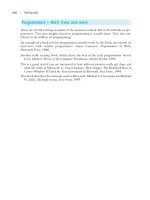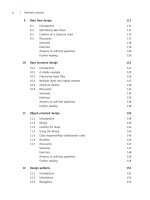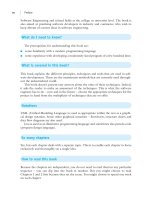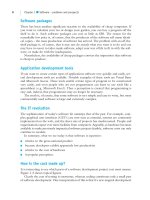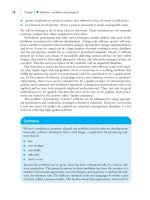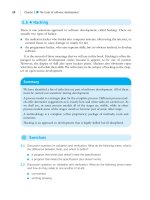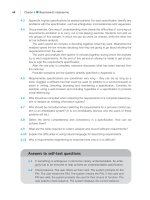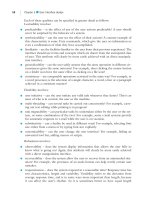Software Engineering For Students: A Programming Approach Part 5 ppsx
Bạn đang xem bản rút gọn của tài liệu. Xem và tải ngay bản đầy đủ của tài liệu tại đây (135.9 KB, 10 trang )
18 Chapter 1 ■ Software – problems and prospects
■ greater emphasis on trying to ensure that software is free of errors (verification).
■ incremental development, where a project proceeds in small, manageable steps
We will be looking at all of these ideas in this book. These solutions are not mutually
exclusive; indeed they often complement each other.
Verification, prototyping and other such techniques actually address only some of the
problems encountered in software development. A large-scale software project will com-
prise a number of separate related activities, analysis, specification, design, implementation,
and so on. It may be carried out by a large number of people working to strict deadlines,
and the end product usually has to conform to prescribed standards. Clearly, if software
projects are to have any chance of successfully delivering correct software on time within
budget, they must be thoroughly planned in advance and effectively managed as they are
executed. Thus the aim is to replace ad hoc methods with an organized discipline.
One term that is used a lot these days in connection with software is the word qual-
ity. One might argue that any product (from a cream bun to a washing machine) that
fulfills the purpose for which it was produced could be considered to be a quality prod-
uct. In the context of software, if a package meets, and continues to meet, a customer’s
expectations, then it too can be considered to be a quality product. In this perspective,
quality can be attained only if effective standards, techniques and procedures exist to be
applied, and are seen to be properly employed and monitored. Thus, not only do good
methods have to be applied, but they also have to be seen to be applied. Such proce-
dures are central to the activity called “quality assurance”.
The problem of producing “correct” software can be addressed by using appropri-
ate specification and verification techniques (formal or informal). However, correctness
is just one aspect of quality; the explicit use of project management discipline is a key
factor in achieving high-quality software.
Summary
We have considered a number of goals and problem areas in software development.
Generally, software developers have a bad image, a reputation for producing soft-
ware that is:
■ late
■ over budget
■ unreliable
■ inflexible
■ hard to use.
Because the problems are so great, there has been widespread talk of a crisis in soft-
ware production. The general response to these problems has been the creation of a
number of systematic approaches, novel techniques and notations to address the soft-
ware development task. The different methods, tools and languages fit within a plan
of action (called a process model). This book is about these approaches. Now read on.
BELL_C01.QXD 1/30/05 4:13 PM Page 18
Exercises 19
These exercises ask you to carry out an analysis and come to some conclusion about a sit-
uation. Often there is no unique “right answer”. Sometimes you will have to make reasonable
assumptions or conjectures. The aim of the exercises is to clarify your understanding of the
goals of software engineering and some of the problems that lie in the path of achieving
these goals.
1.1 Write down a list of all of the different items of software that you know about, then
categorize them within types.
1.2 What are your own personal goals when you develop a piece of software? Why? Do
you need to re-examine these?
1.3 Is software expensive? What criteria did you use in arriving at your conclusion?
1.4 Is programming/software development easy? Justify your answer.
1.5 The evidence suggests that there are enormous differences between programmers in
terms of productivity. Why do you think this is? Does it matter that there are differences?
1.6 For each of the applications described in Appendix A assess the importance of the
various goals identified in this chapter. For each application, rank the goals in order.
1.7 What would you expect the relative costs of hardware and software development to
be in each of the cases above?
1.8 How do you personally feel about software maintenance? Would you enjoy doing it?
1.9 Think of an example of a program in which the aims of minimizing run time and mem-
ory occupancy are mutually contradictory. Think of an example where these two are
in harmony.
1.10 Analyze the conflicts and consistencies between the various goals of software
engineering.
1.11 In addition to the goals described in this chapter, are there any other goals that soft-
ware engineering should strive for? What about making sure that it is fun to do it? What
about exercising creativity and individuality?
Exercises
•
BELL_C01.QXD 1/30/05 4:13 PM Page 19
20 Chapter 1 ■ Software – problems and prospects
Answers to self-test questions
1.1 50 people at a cost of $12.5 million.
1.2 Hardware: $1,000.
Software: $100.
To buy, the hardware is approximately ten times the cost of the software.
1.3 Examples are a Web browser and a telephone switching system.
1.4 Examples of safety critical systems: an ABS braking system on a car, a fire
alarm system, a patient record system in a health center.
Examples of systems that are not safety critical are a payroll system, a
word processor, a game program.
1.5 Some well-known word processor programs incorporate the facility to
search for a file. This facility is not always easy to use, especially when it
fails to find a file that you know is there somewhere.
The DOS operating system provides a command-line command to delete
a file or any number of files. Coupled with the “wild card” feature, denoted
by an asterisk, it is easy to delete more files than you plan, for example:
del *.*
Further reading
•
Accounts of failed projects are given in Stephen Flowers, Software Failure: Management
Failure: Amazing Stories and Cautionary Tales, Stephen Flowers, John Wiley, 1996,
and in Robert Glass, Software Runaways, Prentice Hall, 1998.
This is a good read if you are interested in how software projects really get done and
what life is like at Microsoft. G. Pasacal Zachary, Show-Stopper: The Breakneck Race
to Create Windows NT and the Next Generation at Microsoft, Free Press, a division
of Macmillan, Inc., 1994.
A very readable and classic account of the problems of developing large-scale software
is given in the following book, which was written by the man in charge of the devel-
opment of the software for an IBM mainframe range of computers. It has been
republished as a celebratory second edition with additional essays. Frederick P.
Brooks, The Mythical Man-Month, Addison-Wesley, 2nd edn, 1995.
One of the key design goals of Java is portability. A compelling account of the argu-
ments for portable software is given in Peter Van Der Linden, Not Just Java, Sun
Microsystems Press; Prentice Hall, 1998.
BELL_C01.QXD 1/30/05 4:13 PM Page 20
Further reading 21
Analyses of the costs of the different stages of software development are given in the
following classic book, which is still relevant despite its age: B.W. Boehm, Software
Engineering Economics, Prentice Hall International, 1981.
A fascinating review of disasters caused by computer malfunctions (hardware, software
and human error) is given in Peter G. Neumann, Computer-Related Risks, Addison-
Wesley; ACM Press, 1995.
In conjunction with the ACM, Peter Neumann also moderates a USENET newsgroup
called comp.risks, which documents incidents of computer-related risks. Archives are
available at />For an up-to-date look at how software professionals see their role, look at the
newsletter of the ACM Special Interest Group in Software Engineering, called
Software Engineering Notes (SEN), published bi-monthly. Its Web address is
/>The equivalent periodical from the IEEE is simply called Software. This is produced by
and for practitioners, reflecting their current concerns and interests, such as software
costs.
BELL_C01.QXD 1/30/05 4:13 PM Page 21
In this chapter we identify the significant tasks of software development. The bulk of
this book describes techniques for carrying out these tasks. As part of the story, we
clarify the nature of two important activities that take place throughout software
development – validation and verification.
If you have ever written a program, there a number of activities that you know you
are going to have to carry out, for example, testing. The same is true of larger devel-
opments, but for big programs and large software systems, there are additional ele-
ments. The activities are:
■ a feasibility study
■ requirements engineering
■ user interface design
■ architectural design
■ detailed design
■ programming
■ system integration
■ validation
■ verification (testing)
■ production
CHAPTER
2
The tasks
of software
development
This chapter:
■ identifies the activities within software development
■ explains the idea of a process model
■ explains the term methodology
■ explains the term hacking.
2.1
●
Introduction
BELL_C02.QXD 1/30/05 4:14 PM Page 22
2.2 The tasks 23
■ documentation
■ maintenance
■ project management.
A process model is a plan that makes provision for all these required activities and seeks
to incorporate the stages in a methodical way. At the end of this chapter, we introduce
the idea of process model, which is an overall strategy for accomplishing software devel-
opment. However, while it may seem obvious that they are carried out in a certain order,
we shall see that this is not always the best strategy. For example, it may not be ideal to
carry out validation as the final step. Similarly, not all process models incorporate the
activities as distinct steps.
2.2
●
The tasks
Feasibility study
Before anything else is done, a feasibility study establishes whether or not the project is
to proceed. It may be that the system is unnecessary, too expensive or too risky. One
approach to a feasibility study is to perform cost-benefit analysis. The cost of the pro-
posed system is estimated, which may involve new hardware as well as software, and
compared with the cost of likely savings. This comparison then determines whether the
project goes ahead or not.
Requirements engineering (specification)
At the start of a project, the developer finds out what the user (client or customer)
wants the software to do and records the requirements as clearly as possible. The prod-
uct of this stage is a requirements specification.
User interface design
Most software has a graphical user interface, which must be carefully designed so that
it is easy to use.
Architectural (large-scale) design
A software system may be large and complex. It is sometimes too large to be written as
one single program. The software must be constructed from modules or components.
Architectural, or large-scale design breaks the overall system down into a number of
simpler modules. The products of this activity are an architectural design and module
specifications.
BELL_C02.QXD 1/30/05 4:14 PM Page 23
24 Chapter 2 ■ The tasks of software development
Detailed design
The design of each module or component is carried out. The products are detailed
designs of each module.
Programming (coding)
The detailed designs are converted into instructions written in the programming lan-
guage. There may be a choice of programming languages, from which one must be
selected. The product is the code.
System integration
The individual components of the software are combined together, which is sometimes
called the build. The product is the complete system.
Verification
This seeks to ensure that the software is reliable. According to Barry Boehm (one of the
all-time greats of software engineering), verification answers the question: Are we
building the product right? A piece of software that meets its specification is of limited
use if it crashes frequently. Verification is concerned with the developer’s view – the
internal implementation of the system.
Two types of verification are unit testing and system testing. In unit testing, each
module of the software is tested in isolation. The inputs to unit testing are:
1. the unit specification
2. the unit code
3. a list of expected test results.
The products of unit testing are the test results. Unit testing verifies that the behav-
ior of the coding conforms to its unit specification.
In system testing or integration testing, the modules are linked together and the
complete system tested. The inputs to system testing are the system specification and
the code for the complete system. The outcome of system testing is the completed, test-
ed software, verifying that the system meets its specification.
Validation
This seeks to ensure that the software meets its users’ needs. According to Boehm, val-
idation answers the question: Are we building the right product? Validation is to do
with the client’s view of the system, the external view of the system. It is no use creating
a piece of software that works perfectly (that is tested to perfection) if it doesn’t do what
its users want.
BELL_C02.QXD 1/30/05 4:14 PM Page 24
2.2 The tasks 25
An important example of a validation activity is acceptance testing. This happens at
the end of the project when the software is deemed complete, is demonstrated to its
client and accepted by them as satisfactory. The inputs to acceptance testing are the
client and the apparently complete software. The products are either a sign-off docu-
ment and an accepted system or a list of faults. The outcome is that the system com-
plies with the requirements of the client or it does not.
Current evidence suggests that many computer systems do not meet the needs of their
users, and that therefore successful validation is a major problem in software engineering
today. It is a common experience that users think they have articulated their needs to the
software engineer. The engineer will then spend months or even years developing the
software only to find, when it is demonstrated, that it was not what the user wanted. This
is not only demoralizing for both users and developers, but it is often massively costly in
terms of the effort needed to correct the deficiencies. As an extreme alternative the sys-
tem is abandoned.
It is too easy to blame the requirements analysis stage of development, when in
reality the basic problem is the quality of the communication between users and
developers. Users do not know (and usually do not care) about technicalities, where-
as the software engineer expects detailed instructions. Worst of all is the problem of
some common language for accurately describing what the user wants. The users are
probably happiest with natural language (e.g. English), whereas the software engineer
would probably prefer some more rigorous language that would be incomprehensible
to the users. There is a cultural gap.
Production
The system is put into use. (This is sometimes, confusingly, termed implementation.)
The users may need training.
Maintenance
When the software is in use, sooner or later it will almost certainly need fixing or
enhancing. Making these changes constitutes maintenance. Software maintenance often
goes on for years after the software is first constructed. The product of this activity is
the modified software.
Documentation
Documentation is required for two types of people – users and the developers.
Users need information about how to install the software, how to de-install the soft-
ware and how to use it. Even in the computer age, paper manuals are still welcome. For
general purpose software, such as a word processor, a help system is often provided.
User documentation concentrates on the “what” (the external view) of the software,
not the “how” (the internal workings).
Developers need documentation in order to continue development and to carry out
maintenance. This typically comprises the specification, the architectural design, the
BELL_C02.QXD 1/30/05 4:14 PM Page 25
26 Chapter 2 ■ The tasks of software development
detailed design, the code, annotation within the code (termed comments), test sched-
ules, test results and the project plan.
The documentation is typically large and costly (in people’s time) to produce. Also,
because it is additional to the product itself, there is a tendency to ignore it or skimp
on it.
Project management
Someone needs to create and maintain plans, resolve problems, allocate work to people
and check that it has been completed.
Database design
Many systems use a database to store information. Designing the database is a whole
subject in its own right and is not normally considered to be part of software engin-
eering. Consequently, we don’t tackle this topic within this book.
We will see that, in dividing the work into a series of distinct activities, it may
appear that the work is carried out strictly in sequence. However, it is usual, partic-
ularly on large projects, for many activities to take place in parallel. In particular, this
happens once the large-scale (or architectural) design is complete. It is at this stage
that the major software components have been identified. Work on developing the
components can now proceed in parallel, often undertaken by different individuals.
SELF-TEST QUESTION
2.1 Which stages of software development, if any, can be omitted if the
required software is only a small program?
2.3
●
Process models
We have seen (Chapter 1) that software systems are often large and complex. There is
a clear need to be organized when embarking on a development. What do you need
when you set about a software project? You need:
■ a set of methods and tools
■ an overall plan or strategy.
The plan of action is known as a process model. It is a plan of what steps are going to
be taken as the development proceeds. This term is derived as follows: a process is a step
or a series of steps; a process model is a model in the sense that it is a representation of
BELL_C02.QXD 1/30/05 4:14 PM Page 26
2.4 Methodology 27
reality. Like any model, a model is only an approximation of reality. A process model
has two distinct uses:
■ it can be used as a basis for the plan for a project. Here the aim is to predict what
will be done.
■ it can be used to analyze what actually happens during a project. Here the aim is to
improve the process for the current and for future projects.
There are several mainstream process models:
■ waterfall
■ prototyping
■ incremental
■ agile
■ rational
■ open source
■ seat of the pants, do it yourself or ad hoc.
Each of these approaches will be discussed later in this book, except for the last in
the list. An ad hoc approach is no plan at all, and no organization would admit to using
such an approach. A software development project can take several years and involve
tens or even hundreds of people. Moreover, software development is a complex task.
To avoid catastrophe, some way of organizing a project must be established. Thus most
approaches identify a series of distinct stages within a project, along with a plan of what
order they will occur in.
2.4
●
Methodology
In common language, the word methodology means the study of method. It answers
such questions as: What is the basis of method x? How good is method y? However, in
software development, the term methodology has been kidnapped and come to mean
a complete package of techniques, tools and notations. Such a package is given a name,
say the XYZ methodology, and is often marketed by a corporation, together with
books, manuals and training. Consultants are also on hand to guide an organization in
using the methodology.
In this book, we have avoided describing any particular methodology, but we do
explain all the ingredients that go into making the mainstream methodologies avail-
able today.
BELL_C02.QXD 1/30/05 4:14 PM Page 27
